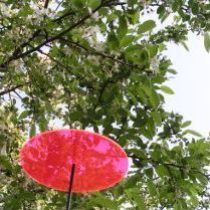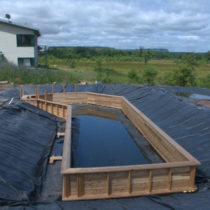Landscape Architecture for Landscape Architects › Forums › DETAILS & MATERIALS › Natural Swimming Pools
- This topic has 1 reply, 11 voices, and was last updated 9 years, 3 months ago by
 Kara Smith.
Kara Smith.
-
AuthorPosts
-
January 24, 2014 at 3:26 am #153349
 Goustan BODINParticipant
Goustan BODINParticipantI actually had a possibility once to go for it and give it a go, for a hotel. This has been discussed, as I put forward the possibility for a NSP, and my client was familiar enough with the concept to have an itch. Now, there was not time for extra-training, or no extra budget for coaching, so when the client asked me if I could vouch 100% for the result, I took some time to ponder, then backed down.
Not sure I made the right choice, it’s no so hard either.
If I had had the possibility to be coached, I’d have jumped in right away ! I guess that if you have that possibility, that project will open you doors to a new world.
January 24, 2014 at 3:35 pm #153348 Miles BarnardParticipant
Miles BarnardParticipantGustan those are great reflections. I am right there. My hope is to convince the client to spend a bit more money on the front end with a BioNova consultant but have me still running the show. I’ll let you all know how my ‘pitch’ is received.
January 24, 2014 at 3:53 pm #153347 Goustan BODINParticipant
Goustan BODINParticipantGood luck, keep us posted !
February 1, 2014 at 9:52 pm #153346 Miles BarnardParticipant
Miles BarnardParticipantNSP project update. I am going to hire a consultant to provide design guidance on the pool systems and material selections. I will still be the designer of record and also manage the construction aspects of the project. I’m choosing between two companies, BioNova and Total Habitat out of Kansas. I am leaning toward Total Habitat because I like that they are an american-based company and have none of the overly protective proprietary bs that a company like BioNova brings to the table. Mick Hilleary of Total Habitat is eager to see more NSPs built and just wants to be part of that. In fact is was Total Habitat’s Guide to building NSPs that Todd Chambers posted on this forum discussion. There is now a second edition to that which I just purchased. I will keep updating as things progress. -Miles
February 1, 2014 at 9:54 pm #153345 Miles BarnardParticipant
Miles BarnardParticipantTodd thanks again. I’m leaning toward hiring the guys (Total Habitat) that wrote this guide to be consultants on my project.
February 4, 2014 at 3:01 pm #153344 Janine MicunekParticipant
Janine MicunekParticipantOn the Grothe site, go to Referenzen > Badeparadies and also to Partner > Teichmeister. On that last site, you can see more visuals, especially architectonic designs, which I find most exciting. You can have the clean look of a swimming pool but without the chlorine. Note that the planting zone does not necessarily have to be one with the swimming zone.
February 4, 2014 at 3:04 pm #153343 Janine MicunekParticipant
Janine MicunekParticipantI think you need to be straightforward with clients and contractors and only work with those willing to do some trial and error with you. I might have one here in Michigan to work with me. You also will need some legal assistance to protect yourself in case something does not work out.
Btw thank you so much for posting about this; it is such an exciting new field. And apparently a very lucrative one … Looking forward to more updates!
February 21, 2014 at 2:10 am #153342 Laura StabellParticipant
Laura StabellParticipantI have dealt with water gardens, bog gardens,wetlands and other water quality issues. Water is never easy! I designed-never built my own natural pool. This will be a trial and error project. An inexpensive construct might be done using a liner. I’ve used fish quality vinyl-good till a deer waded in. Industrial vinyl pond and canal lining is available now-drinking water quality. Construction suppliers have it for lining chemical lagoons and dumps-so it should hols up. Fish quality butyl rubber is good but expensive-might be more resilient. Just bought poly pond liner/roof garden material from farm tec that I like best. I used 6 mill poly to do bog gardens-a few layers thick in the past. This is 36 mill thick and durable. All lined ponds need to have the hole lined to avoid puncturing from below. If your customer is “green” recycled synthetic carpeting is easy to get from installers for free. The surface also has to be covered to protect from UV rays. This works great for a natural pool where a sand or pebble beach and natural appearance are the goal. The liner needs protecting from above so material can be put on it. Felt carpet padding works great for this. It seems indestructible (Can also be found free) and works as a filter.You should be able to place big stones on top of it by cutting out circles and adding more layers of padding under the stones-bigger stone-more layers. I love to use bank run coarse grade gravel to line the ponds. It is available in my area (tristate) at a very inexpensive price and has all sizes from sand to small round boulders mixed together. The art comes from how you sort the stones. This is a glacial till-so stones are smooth and the sand is sharp(the best filtering sand). It looks gross when it arrives-just wash it. You could also build up the felt sand-gravel in a few layers to filter more. A pump inlet can be buried below layers to suck the water through the layers. The pump is best above at the top of your installation to replace easily.(make sure suction is diffused so it doesn’t suck someone down and hold them under) The upper ponds can be bogs(pool filled almost with gravel) or ponds.I have used wood to remove nitrogen from natural wetlands by building “beaver dams”.Sewage effluent sent through a series of streams filled with plants ended up with drinking water quality water-so more plants and distance=cleaner water. If your water turns green, oat straw bales work well but are somewhat costly.I was thinking of trying bio-char to filter water. Free for the making from brush on site(might make the water smell smokey for a time) A large pit filled with it capped over with gravel should filter the water of nutrients and toxins.Some larger single celled organisms also turn the water green-many proliferate then die out for good given some time. Kids peeing can turn water green overnight.Ducks might bring duckweed in-tiny plant,tough customer-maybe out compete it with water hyacinth? PH affects water-alkaline PH seems to create more rock slime acidic PH seems to kill off slime(and other life if too high) To recap: Soil base/carpet/pond liner/carpet felt padding/stones-gravel-sand/ plants. Just do it-have fun-give extra time to work out bugs free of charge. Education costs money.
February 21, 2014 at 12:48 pm #153341 Miles BarnardParticipant
Miles BarnardParticipantLaura I’m out of breath reading your post. Great information. Thanks so much. We definitely want to have a beach entrance at one end and I like the rocky interior
February 24, 2014 at 3:29 pm #153340 Jason CookParticipant
Jason CookParticipantMiles, I have the first edition of Total Habitat’s book. Do you have the 2nd edition? If so, what differences/improvements are there? I’d love a copy. Thanks.
February 25, 2014 at 7:42 pm #153339 Laura StabellParticipant
Laura StabellParticipantHi Miles,
I was just reading Permaculture Magazine(UK). Somebody was writing about using bamboo charcoal for drinking water filtration. I dont know if its better than plain wood charcoal.
Also there people have something called “reed beds” to handle their effluent. I wouldn’t think that would fly here with health dept regulations unless it was covered. I have seen some long glass covered “pits” designed in the US. Im not sure what reed is used- probably cat tails,Typha latifolia , maybe Phragmites? Not a non native invasive in UK like here.
February 25, 2014 at 7:54 pm #153338 Miles BarnardParticipant
Miles BarnardParticipantLaura I have heard of the reed bed thing for effluent. There actually is some openness from the health dept folks here to talking about treating effluent with constructed wetlands.
February 26, 2014 at 9:39 pm #153337 Jason CookParticipant
Jason CookParticipantMiles, do you not have a copy of the 2nd edition? Thanks again.
February 27, 2014 at 6:56 pm #153336 Laura StabellParticipant
Laura StabellParticipantThat’s amazing-I guess the concerns of the past have faded in the post cholera era?! In my area septic systems are the largest nitrogen contributor to the rivers-except the occasional horse farm which spot contaminates the surface waters. The sewage treatment plants take some things out but not enough. Diversion permits between water tables and TMDL’s in some streams cut the size of treatment plants and reduce development (thankfully in some cases) Some of the regional cities have failing sewage treatment facilities. Nobody has suggested constructed wetlands that I have heard of.-(except for me) One city was given a waiver from updating its facilities if it cut down on lawn fertilizer use among its residents.
That speaks loud to me how polluting fertilizers are. I’ve always advocated water insoluble nitrogen and mineral fertilizers for that reason. When your pool is in place, its important the lawn guy doesn’t fertilize around the pool and also that the pool isn’t catching runoff from the septic or fertilized areas. Leaves, grass clippings and the like have to be cleaned and cleared out.
I just saw an ad for a company doing pond vacuuming, diver harvesting and fabric lining to reduce weed growth. Northeast Diving Services –http://www.northeastdivingservices.net (I have to admit though-that I think their “before” photo of the pond with the lily pads is preferable to me! Lily pads keep the water cooler which is another way to keep weed growth down.) A septic system garbage pump might be used to suck the muck periodically. Maybe installed in the low point? Water can be screened and filtered and sent back through the system .
There also comes to mind clarifying agents used in wine making. Betonite is one that is used but is listed in some toxicology books as a toxin as well as a potential source of natural PCB’s depending on the mine source of (any) clay. I thought I read of cream of tarter being another-Wikipedia lists more. The use of such material is that it might speed the clarifying of the water, making particles settle so they can be cleaned out. Except for diatomaceous earth (can cause lung problems)and activated charcoal, I haven’t seen any being used commercially in water treatment of pools or ponds. If you have a local sewage treatment plant-they probably can clue you in to any water treatment chemicals used commercially. I think I have read about flocculants being part of the process. My point is, a natural safe clarifying agent might be a useful thing to find to quickly treat water turned murky or to be used as part of the maintenance process.
Have to go! Next time I have to clue you in on snails!
May 8, 2014 at 9:41 pm #153335 Miles BarnardParticipant
Miles BarnardParticipantAnnie thanks. But we are talking about natural swimming pools. Non conventional chemical pools. -Miles
-
AuthorPosts
- You must be logged in to reply to this topic.

